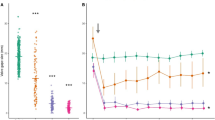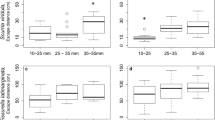Abstract
The gastropod Calliostoma canaliculatum displays a series of aggressive escape behaviors upon contact with tube feet of the predatory seastars Pycnopodia helianthoides and Pisaster giganteus. Escape behaviors are predator specific. Calliostoma canaliculatum moves away from contact with P. giganteus more frequently than P. helianthoides, clamping down with the foot or retracting the head and foot into the shell when exposed to P. helianthoides. If escape from the grasp of either seastar fails, C. canaliculatum releases a yellow-colored exudate from the hypobranchial gland and subsequently retracts both the head and foot fully into the shell. This exudate contains noxious compound(s) as evidenced by retraction of tube feet and arms away from the exudate in both seastars. Tube-foot retraction responses to dilutions of the exudate indicates that both species of seastars are able to detect the exudate at a concentration of 3.2 × 10−3 mg exudate/ml seawater. Pisaster giganteus is more responsive to the exudate than Pycnopodia helianthoides, moving away from the source as well as retracting the tube feet and arm. Snails spread the exudate over their shells with their foot, perhaps to ensure defense from predators for some time period after exudate release. The exudate was collected and extracted in chloroform–ethyl acetate (1:1), then fractionated using flash chromatography. The most bioactive fraction, as evidenced by tube-foot retraction, was soluble in ethyl acetate and appeared to contain two major compounds.
Similar content being viewed by others
REFERENCES
ALEXANDER, J. E., and COVICH, A. P. 1991. Predator avoidance by the freshwater snail Physella virgata to the crayfish Procambarus simulans. Oecologia 87:435–442.
ANSELL, A. D., and MORTON, B. 1987. Alternative predator tactics of a tropical natacid gastropod. J. Exp. Mar. Biol. Ecol. 111:109–119.
BAKUS, G. J., TARGETT, N. M., and SCHULTE, B. 1986. Chemical ecology of marine organisms: an overview. J. Chem. Ecol. 12:951–987.
BARNES, R. D. 1987. Invertebrate Zoology, 5th ed. Saunders, Philadelphia, 893 pp.
BRUNO, I., MINALE, L., and RICCIO, R. 1989. Starfish saponins, 38. Steroidal glycosides from the starfish Pycnopodia helianthoides. J. Nat. Prod. 52:1022–1026.
COLEY, P. D., BRYANT, J. P., and CHAPIN, F. S., III. 1985. Resource availability and plant antiherbivore defense. Science 230:895–899.
DAYTON, P. K., ROSENTHAL, R. J., MAHEN, L. C., and ANTEZANA, T. 1977. Population structure and foraging biology of the predaceous Chilean asteroid Meyenaster gelatinosus and the escape biology of its prey. Mar. Biol. 39:361–370.
DIMATTEO, T. 1981. The inking behavior of Aplysia dactylomela (Gastropoda: Opisthobranchia): Evidence for distastefulness. Mar. Behav. Physiol. 7:285–290.
DIMATTEO, T. 1982. The ink of Aplysia dactylomela (Gastropoda: Opisthobranchia) and its role as a defense mechanism. J. Exp. Mar. Biol. Ecol. 57:169–180.
DUVAL, M. A., CALZETTA, A. M., and RITTSCHOF, D. 1994. Behavioral responses of Littoraria irrorata (Say) to waterborne odors. J. Chem. Ecol. 20:3321–3334.
FAULKNER, D. J. 1992. Chemical defenses in marine molluscs, pp. 119–163, in V. J. Paul (ed.). Ecological Roles of Marine Natural Products, Comstock, Ithaca, New York.
FEDER, H. M. 1963. Gastropod defensive responses and their effectiveness in reducing predation by starfishes. Ecology 44:505–512.
FEDER, H. M. 1967. Organisms responsive to predatory seastars. Sarsia 29:371–394.
FENICAL, W., and PAWLIK, J. R. 1991. Defensive properties of secondary metabolites from the Caribbean gorgonian coral Erythropodium caribaeorum. Mar. Ecol. Prog. Ser. 75:1–8.
FRETTER, V., and GRAHAM, A. 1962. British Prosobranch Molluscs. Their Functional Anatomy and Ecology. Ray Society, London, 755 pp.
GORE, R. H. 1966. Observations on the escape response in Nassarius vibex (Say), Mollusca: Gastropoda. Bull. Mar. Sci. 16:423–434.
HARROLD, C. 1982. Escape responses and prey availability in a kelp forest predator-prey system. Am. Nat. 119:132–135.
HARVEY, C., GARNEAU, F. X., and HIMMELMAN, J. H. 1987. Chemoreception of the predatory seastar Leptasterias polaris by the whelk Buccinum undatum. Mar. Ecol. Prog. Ser. 40:79–86.
HAY, M. E., and FENICAL, W. 1988. Chemically-mediated seaweed herbivore intractions. Annu. Rev. Ecol. Syst. 19:111–145.
HERRLINGER, C. 1980. Kelp forest prey refugia—an interaction among gastropods, cnidarians, and seastars. Am. Zool. 24:A24.
HOFFMAN, D. L., HOMAN, W. C., SWENSON, J., and WELDON, P. J. 1978. Flight responses of three congeneric species of intertidal gastropods to sympatric predatory gastropods from Barbados. Veliger 21:293–296.
LINDQUIST, N., and FENICAL, W. 1991. New tambjamine class alkaloids from the marine ascidian Atapoza sp. and its nudibranch predator—origin of the tambjamines in Atapoza. Experentia 47:504–506.
MACKIE, A. M. 1970. Avoidance reactions of marine invertebrates to either steroid glycosides of starfish or synthetic surface-active agents. J. Exp. Mar. Biol. Ecol. 5:63–69.
MACKIE, A. M., LASKER, R., and GRANT, P. T. 1968. Avoidance reactions of a mollusc Buccinum undatum to saponin-like surface-active substances in extracts of the starfish Asterias rubens and Marthasterias glacialis. Comp. Biochem. Physiol. 26:415–428.
MCCLINTOCK, J. B. 1985. Avoidance and escape responses of the sub-Antarctic limpet Nacella edgari (Powell) (Mollusca, Gastropoda) to the seastar Anasterias perrieri (Smith) (Echinodermata, Asteroidea). Polar Biol. 4:95–98.
MCCLINTOCK, J. B. 1987. Investigation of the relationship between invertebrate predation and biochemical composition, energy content, spicule armament and toxicity of benthic sponges at McMurdo Sound, Antarctica. Mar. Biol. 94:479–487.
MCCLINTOCK, J. B., BAKER, B. J., SLATTERY, M., HAMANN, M., KOPITZKE, R., and HEINE, J. N. 1994. Chemotactic tube-foot responses of a spongivorous seastar Perknaster fuscus to organic extracts from antarctic sponges. J. Chem. Ecol. 20:859–870.
MENGE, J. L. 1974. Prey selection and foraging period of the predaceous rocky intertidal snail, Acanthina punctulata. Oecologia 17:293–316.
MILLER, M. 1986. Avoidance and escape responses of the gastropod Nucella emarginata (Deshayes, 1839) to the predatory seastar Pisaster ochraceus (Brandt, 1835). Veliger 28:394–396.
NOLEN, T. G., JOHNSON, P. M., KICKLIGHTER, C. E., and CAPO, T. 1995. Ink secretion by the marine snail Aplysia californica enhances its ability to escape from a natural predator. J. Comp. Physiol. 176A:239–254.
NORTON, S. F. 1988. Role of the gastropod shell and operculum in inhibiting predation by fishes. Science 241:92–94.
PAINE, R. T. 1969. The Pisaster-Tegula interaction: Prey patches, predator food preference, and intertidal community structure. Ecology 50:950–961.
PAINE, R. T. 1974. Intertidal community structure: experimental studies on the relationship between a dominant competitor and its principal predator. Oecologia 15:93–120.
PAUL, V. J., LINDQUIST, N., and FENICAL, W. 1990. Chemical defenses of the tropical ascidian Atapoza sp. and its nudibranch predators Nembrotha spp. Mar. Ecol. Prog. Ser. 59:109–118.
PAUL, V. J. 1992. Ecological Roles of Marine Natural Products. Comstock, Ithaca, New York, 245 pp.
PAWLIK, J. R. 1993. Marine invertebrate chemical defenses. Chem. Rev. 93:1911–1922.
PENNINGS, S. C. 1994. Interspecific variation in chemical defenses in the sea hares (Opisthobranchia: Anaspidea). J. Exp. Mar. Biol. Ecol. 180:203–219.
PHILLIPS, D. W. 1976. The effect of a species specific avoidance response to predatory starfish on the intertidal distribution of two gastropods. Oecologia 23:83–94.
PHILLIPS, D. W. 1977. Avoidance and escape responses of the gastropod mollusc Olivella biplicata (Sowerby) to predatory asteroids. J. Exp. Mar. Biol. Ecol. 28:77–86.
PHILLIPS, D. W. 1978. Chemical mediation of invertebrate defensive behaviors and the ability to distinguish between foraging and inactive predators. Mar. Biol. 49:237–243.
QUINN, R. J., BARTLETT, R. T., COOK, A. F., and GREGSON, R. P. 1980. Isolation and synthesis of I-methylisoguanosine, a potent pharmacologically active constituent from the marine sponge Tedania diditata. Tetrahedron Lett. 21:567–568.
RHOADES, D. F., and CATES, R. G. 1976. Toward a general theory of plant antiherbivore chemistry. Recent Adv. Phytochem. 10:168–213.
SLATTERY, M., and MCCLINTOCK, J. B. 1995. Population structure and chemical defense in three shallow-water antarctic soft corals. Mar. Biol. 122:461–470.
VANALSTYNE, K. L., and PAUL, V. J. 1992. Chemical and structural antipredator defenses in the sea fan Gorgonia ventalina: Effects against generalist and specialist predators. Coral Reefs 11:155–159.
WALKER, R. P., THOMPSON, J. E., and FAULKNER, D. J. 1985. Exudation of biologically active metabolites in the sponge Aplysina fistularis. II. Chemical evidence. Mar. Biol. 88:27–32.
WELDON, P. J., and HOFFMAN, D. L. 1979. Kick and thrust foot movements in the righting and escape behavior of marine prosobranch gastropods (Mollusca: Gastropoda). Z. Tierpsychol. 50:387–398.
WYLIE, C. R., and PAUL, V. J. 1989. Chemical defenses in three species of Sinularia (Coelenterata, Alcyonacea): Effects against generalist predators and the butterflyfish Chaetodon unimaculatus Bloch. J. Exp. Mar. Biol. Ecol. 129:141–160.
ZOLLO, F., FINAMORE, E., MARTUCCIO, C., and MINALE, L. 1990. Starfish saponins, part 44. Steroidal glycosides from the starfish Pisaster giganteus. J. Nat. Prod. 53:1000–1005.
Rights and permissions
About this article
Cite this article
Bryan, P.J., Mcclintock, J.B. & Hamann, M. Behavioral and Chemical Defenses of Marine Prosobranch Gastropod Calliostoma canaliculatum in Response to Sympatric Seastars. J Chem Ecol 23, 645–658 (1997). https://doi.org/10.1023/B:JOEC.0000006401.97339.b9
Issue Date:
DOI: https://doi.org/10.1023/B:JOEC.0000006401.97339.b9




